Midi-Pyrénées
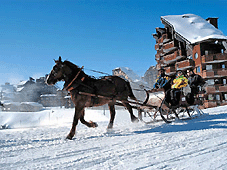 The Midi-Pyrénées is divided into the departments Ariège, Aveyron, Gers, Haute-Garonne, Hautes-Pyrénées, Lot, Tarn and Tarn-et-Garonne. In the old days, this realm was ruled by the counts of Toulouse. The province is very diverse. Especially when you enjoy nature, walking, mountain scenery, culture and beautiful car journeys, this province in France is a good choice for the Summer holidays. In Winter the south of this province is interesting, with the famous Winter sports stations like Ax-les-Thermes and Font Romeu in the Pyrenees mountains. The capital is Toulouse. But the most famous town in the Midi-Pyrénées is without doubt, Lourdes, followed by the most famous Cathar castle in the world: Montségur.
The Midi-Pyrénées is divided into the departments Ariège, Aveyron, Gers, Haute-Garonne, Hautes-Pyrénées, Lot, Tarn and Tarn-et-Garonne. In the old days, this realm was ruled by the counts of Toulouse. The province is very diverse. Especially when you enjoy nature, walking, mountain scenery, culture and beautiful car journeys, this province in France is a good choice for the Summer holidays. In Winter the south of this province is interesting, with the famous Winter sports stations like Ax-les-Thermes and Font Romeu in the Pyrenees mountains. The capital is Toulouse. But the most famous town in the Midi-Pyrénées is without doubt, Lourdes, followed by the most famous Cathar castle in the world: Montségur.Below we would like to show you some of the most interesting places to see in the Midi-Pyrénées.
THE NORTH
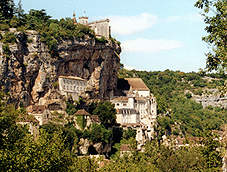 Rocamadour
RocamadourThis famous pilgrim site is a very popular day trip in Summer for both the French as well as foreign visitors. On top of a 150 meter high rock lies the old town, called the Cité. Between the 12th and 14th century this town was an important stop on one of the routes to Santiago de Compostela.
You can stroll through the old streets which are filled with souvenir shops and little restaurants and bars. The town can be best photographed from the road on the opposite site of the town.
Interesting sites are among others: the Black Madonna in the Chapelle Notre Dame, the large stair case following the stations of the cross to the 14th century castle and the Grotte de Merveilles nearby, where you can admire prehistoric cave paintings in a small grotto.
Tip: When you are driving towards the Cité, you will arrive at a large parking, from where you can walk towards the castle and the large stair case which lead to the old town. At the end of your visit you can use the elevator to go back up.
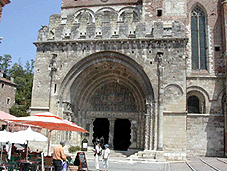 At Moissac the river Tarn starts its journey. This lovely town is lying leisurely in between the vineyards, as many French towns do. A visit to the 7th century abbey of St. Pierre is an absolute must. This abbey was plundered by Arabs, Normans and Hungarians throughout the ages. In 1047 it was annexed to the famous abbey of Cluny. Under abbot Durand de Bredon, the abbey florished. In the 12th century it became the most important abbey of France. There are lovely details all around and inside the abbey.
At Moissac the river Tarn starts its journey. This lovely town is lying leisurely in between the vineyards, as many French towns do. A visit to the 7th century abbey of St. Pierre is an absolute must. This abbey was plundered by Arabs, Normans and Hungarians throughout the ages. In 1047 it was annexed to the famous abbey of Cluny. Under abbot Durand de Bredon, the abbey florished. In the 12th century it became the most important abbey of France. There are lovely details all around and inside the abbey.Conques is situated in a beautiful landscape, on the banks of the river l'Ouche, which has grinded itself deep into the rocks to create a gorge. The Gorges de Dourdou is one of the most beautiful of the area. In medieval Conques you van visit the Romanesque abbey church of St. Foy. Building work started in the 11th century and were completed in the 12th century. This abbey was very powerful and rich. It also gave refuge to pilgrims who were on a journey to Santiago de Compostela.
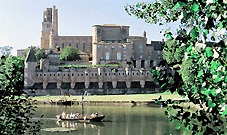 Albi
AlbiAlbi was called Albiga in Roman times. In the Middle Ages, Albi became the seat of a bisshop. In the Scriptorium, the most important liturgic books were copied. The Albigensians, a group of Christians with several contrasting ideas, also known as the Cathars, were sometimes named after the town of Albi, eventhough the Albi was never the most important centre of Catharism. After the Religeous Wars in the 16th century, new industries are introduced in the 17th century like glass blowing and brick baking. in the 18th century also yarn, ropes and candles were produced here.
The most important place to see is the cathedral and the La Berbie Palace. The cathedral of Sainte-Cecile was built between 1282 and 1480 in Gothic style, and is the largest brick building in the world. The interior is breath taking and worth a visit.
The Pont Viex is the oldest bridge from the 12th century. It has 8 arches and is 151 meters long. In the Musée Toulouse-Lautrec you can see a collection of paintings, drawings, posters and lithographs of the artist. The museum is housed in the Palais de la Berbie. This palace was originally the 13th century bisshop's palace. Near the castle are wonderful gardens, close to the Tarn river. Also visit the Saint-Salvy church with its beautiful Romanesque cloister from the 13th century. Albi is also a nice town to just stroll through, it has some really nice shops. The Renaissance buildings and the home of art painter Henri de Toulouse-Lautrec are also worth a vist.
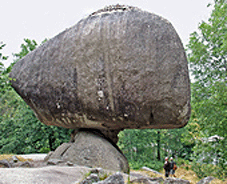 Situated in the Tarn region is a prehistoric area called 'The Sidobre'. Amazing stone formations and rock shapes give this area an enchanted atmosphere. There are also rocks called 'trembling rocks' (roques tremblantes). Early humans must have felt this beautiful area to be sacred. In the course of time, people started to give the rocks names.
Situated in the Tarn region is a prehistoric area called 'The Sidobre'. Amazing stone formations and rock shapes give this area an enchanted atmosphere. There are also rocks called 'trembling rocks' (roques tremblantes). Early humans must have felt this beautiful area to be sacred. In the course of time, people started to give the rocks names.
There is a visitor centre with information about scenic routes, walks and sites to see. Always make sure you do not leave any litter behind when you stop for a drink or a pick nick.
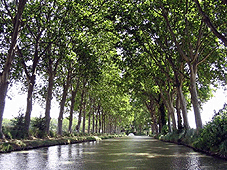 The Canal du Midi
The Canal du MidiAlready in Roman times there were plans cut through France to connect the Mediterranean Sea with the Atlantic if only to avoid the dangerous sea route around Gibraltar (the 'Gate of Hercules'). Much later, in the 17th century, this waterway was realized by means of digging a 240 km long canal, via Toulouse, Carcassonne and Sète to the blue Med. The works were supervised by Baron Riquest.
It takes over 100 locks to overcome the differences in height. To secure the water flow in the higher regions, a lake was realized between Villefranche and Castelnaudary, making use of several rivers.
The canal is not suitable for ships longer than 30 meters and deeper than 1.60 meters. Today the canal is used for recreational purposes.
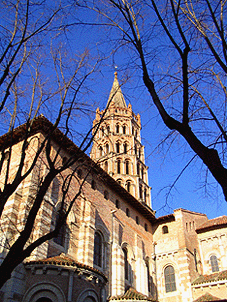 Toulouse
Toulouse Toulouse is the capital of the region Occitania, situated on the Garonne River. Ever since the 13th century it has a university, the first in France outside of Paris. Around 200 B.C.E., Tolosa Tectosagum was founded by the Gauls. Around 120 B.C.E., a Roman army was stationed in Tolosa and by the 3rd century C.E., under Emperor Diocletianus (284-305), the city had become a fortified Roman city with theatres, public baths, temples, etc. During the digs for the modern metro system, parts of this Roman city were rediscovered.
In 418 the Visigoths conquered Tolosa, after which it was ruled by king Walia (418), Theodorik I (418-451), Thorismond (451-453), Theodorik II (453-466), Eurik (466-484) en Alarik (484-507). In 507, the Frankish King Clovis conquered the realm of the Visigoths. Only then, Tolosa became an unimportant city. In 721, Tolosa was conquered by the Arabic emir Al Samh, but this did not last long, for soon, Charles Martel would conquer the Arabs at Poitiers, and Tolosa once again became Frankish.
The history of the county of Toulouse starts in 778, when Charlemagne made Chorson count of Toulouse. In those days the region still had the freedom of religion, so it became a fertile soil for Gnostic groups, such as the Cathars. In the early 13th century, during the Crusade against the Cathars (or Albigensians) lead by Simon de Montfort, the cities of Béziers, Carcassonne, Minerve and also Toulouse were conquered in a very cruel way. The first French monastery run by the Dominicans, who preached against the Cathar heresy and invented torture, was situated in Toulouse.
The sites not to miss are especially the cathedral of Saint-Etienne and the Church of Saint-Sernin. The town centre is a good place for shopping and there are also several museums in Toulouse, such as the Musee Saint-Raymond - Musee des Antiques de Toulouse.
THE SOUTH
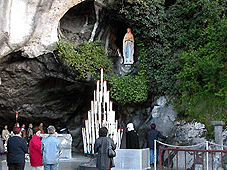 Lourdes
LourdesThis old city and world-famous pilgrims site is situated on the Gave de Pau, at a height of 400 meters. On a clear day you have a magnificent view towards the highest peaks of the Pyrenees and Gavarnie. The development of Lourdes, from a modest market town to one of the most visited pilgrim sites in the world, dates from after 1858, when the 14 year old Bernadette Soubirous, the daughter of a poor millar, saw a lady in white in the nearby Massabielle-rock cave; and not just once, but 18 times.
On March 15th, 1858, this white lady identified herself to Bernadette as the 'Immaculate Conception'. In 1962, the bishop of the diocese of Tarbes (of which Lourdes is a part) confirmed the supernatural origin of the apparitions and in that same year, work started to build a church, the 'Basilique Supérieure', atop the cave where the apparition had taken place.
In 1866, Bernadette entered the 'Soeurs de la Charité' in Nevers and died in 1879. In 1925 she was beatified and in 1933 she became a saint. Lourdes is visited by approximately 5 million visitors ever year.
The international pontifical mass takes place in the underground Pius X basilica. Make sure you are there on time; experience shows that the Pius X basilica is already full one hour before the mass.
In the Diarama you will hear the life story of Bernadette. After this you can take a walk along the cachot and the mills where Bernadette and her family lived.
Anyone who wants to can also visit the baths. At 4.30 pm there is a sacrament procession or a blessing of the sick; an impressive experience.
You can also visit the museum of Lourdes, or walk around the old city center and find the right souvenir to take home with you.
In Auch you can visit the impressive cathedral, which is famous for its red-violet stained glass windows and especially for the 113 sculpted choir stalls.
The Ariège is a magnificent area, situated in the south of the region Midi-Pyrénées. Here you can find many caves, some of them open to the public, the famous Cathar stronghold of Montségur and several other castles such as Lordat, and wintersport ski stations like Ax-les-Thermes and Font Romeu.
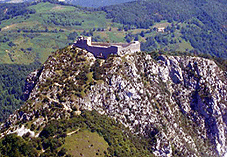 Montségur
MontségurThis is the most famous Cathar castle in France, located near the eponymous village, where you can also have a delicious lunch. In 1204, on the site of a former building, a second castle was erected where the soldiers of Pierre-Roger de Mirepoix were stationed. The regional Cathar community lived around the castle. Montségur was one of the last Cathar castles that had not yet been conquered by the French crown, but taking the castle was not an easy task. The siege began in July 1243 and many months later, in harsh winter conditions, a catapult (trébuchet) was built by the French army and its large stone rocks destroyed the buildings of the castle. On March 1, both sides made a truce that would last for 15 days. Pierre-Roger decided to surrender in exchange for the promise that he and his garrison would be spared.
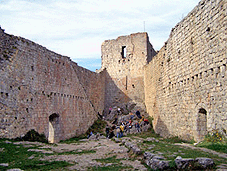 During the 2-week truce, several Cathars managed to escape with unknown baggage, most probably Cathar texts and documents belonging to the Cathar Church. This would become the basis of a Grail legend. The Cathars who refused to denounce their faith, ended up on a huge pyre built just below the mountain on a field either behind the old smithy (now the parking) or opposite the road on an even plot of land. The others were set free.
During the 2-week truce, several Cathars managed to escape with unknown baggage, most probably Cathar texts and documents belonging to the Cathar Church. This would become the basis of a Grail legend. The Cathars who refused to denounce their faith, ended up on a huge pyre built just below the mountain on a field either behind the old smithy (now the parking) or opposite the road on an even plot of land. The others were set free. The fortress you see today is the ruin of a third castle, built by the new lord of Mirepoix, Guy de Lévis II in 1245. This third castle was built upon the ruins of the Cathar stronghold. At the foot of the donjon (tower), at the north-western part of the rock, the remains of the Cathar village can still be seen. Just above the parking is the monument, built in 1960 to commemorate the Cathars and their horrible fate on that tragic day of March 16th, 1244.
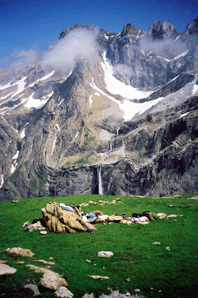 In the south, the region is dominated by the impressive mountain range of the Pyrenees. The Pyrenees seem to form some sort of country on its own, with its own culture, values, and dialects. The mountain range, which stretches from east to west, is currently the border between France and Spain. It started its life around 150 million years ago, when Spain was pushed into France with great force by the enormous trust of the African plate, which moved northwards. Because of this force the rocky crust was pushed up and much of the shallow sea - that used to exist there - vanished underneath the mountain range. The movement came to a full stop about 100 million years ago, and then, erosion started to shape its form, creating the beautiful landscape we see today. Because of these natural forces, a unique habitat was created, where nature and local culture go hand in hand. It is an interesting part of the world that hasn't given up all of its secrets just yet...
In the south, the region is dominated by the impressive mountain range of the Pyrenees. The Pyrenees seem to form some sort of country on its own, with its own culture, values, and dialects. The mountain range, which stretches from east to west, is currently the border between France and Spain. It started its life around 150 million years ago, when Spain was pushed into France with great force by the enormous trust of the African plate, which moved northwards. Because of this force the rocky crust was pushed up and much of the shallow sea - that used to exist there - vanished underneath the mountain range. The movement came to a full stop about 100 million years ago, and then, erosion started to shape its form, creating the beautiful landscape we see today. Because of these natural forces, a unique habitat was created, where nature and local culture go hand in hand. It is an interesting part of the world that hasn't given up all of its secrets just yet...In prehistory there were many floods in France, some lasting long periods of time, and mountain ranges would become islands where life continued. Especially here, the first humans found a safe hunting ground, with plenty of caves, fresh water and wildlife to hunt. Although tools were found that date back to 950.000 years, the first human remains that were found date from ca. 450.000 years ago. These remains and the history of humankind can be discovered in the Tautavel Museum in Tautavel. Later, around 20.000 years ago, the Cro-Magnon even started to plant seeds and keep herds. They were the people who domesticated the wolf. They lived in the mountains as shepherds of sheep and goats, who were the main source of life in the late Stone Age.
Today, only a few bears and several packs of wolves live in the Aspe and Ossau valleys, and a herd of around 2500 wild goats. Many large birds of prey, such as vultures and eagles, grow in numbers, indicating a healthy natural balance in the mountains. Because of the differences in height and climate there is a large diversity in flora and fauna. During hikes you may see wild rhododendrons, daffodils, blue irises, edelweiss, 'ramondias' and many other beautiful wild flowers.
Of course there are many myths and legends in the Pyrenees. According to one legend, the mountains were named after Pyrene, the daughter of a king of the Cerdagne region. She was so beautiful, that even the Greek demi god Hercules seduced her. Pyrene fell madly in love with him and followed him everywhere, but one day she was attacked and killed by wild beasts. Hercules was distraught. In his grief he piled up so many stones on top of her tomb (some say this is in the Lombrives Caves), that he accidentally created the mountain range. Lombrives is the largest cave in Europe and the most famous after Niaux (cave paintings).